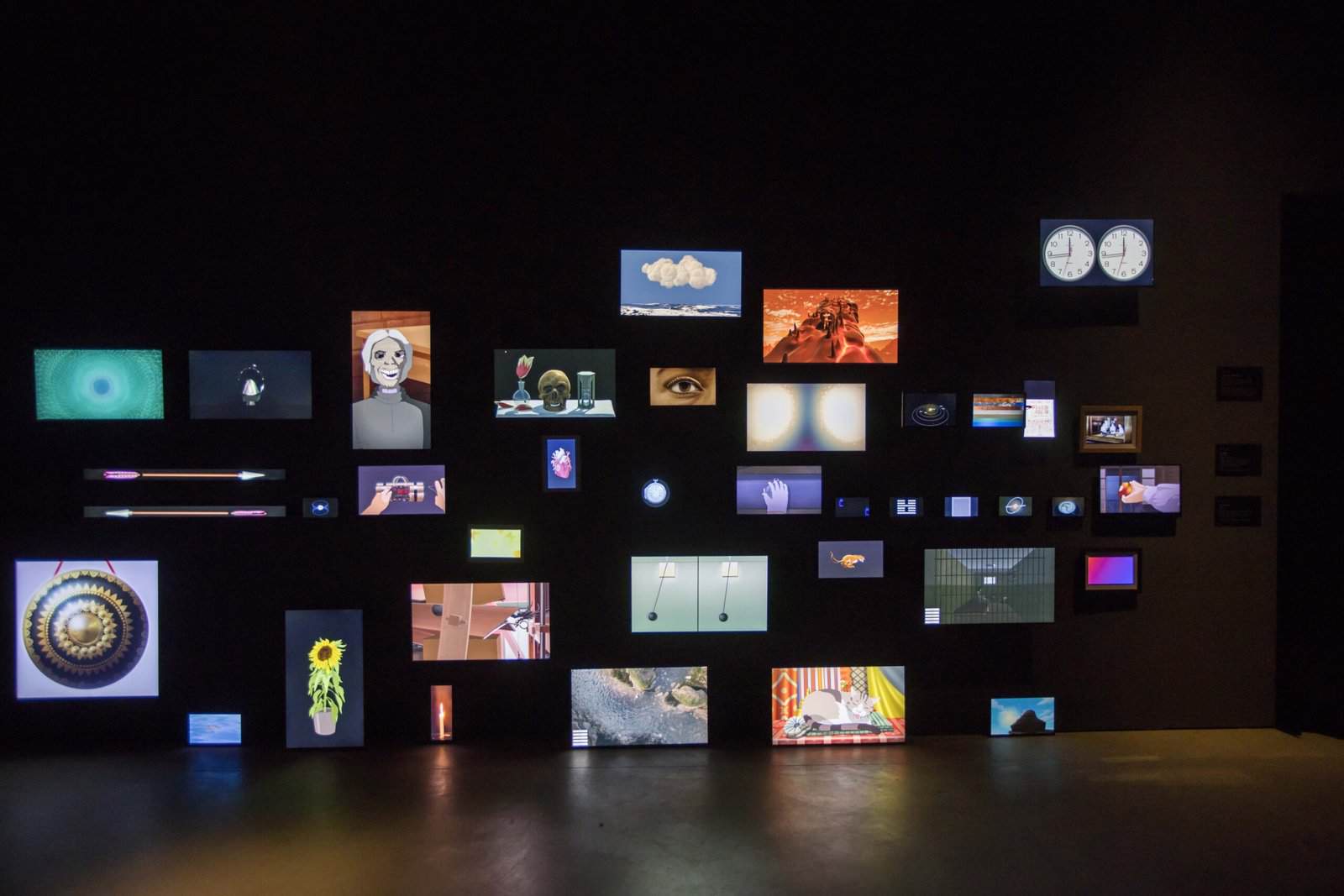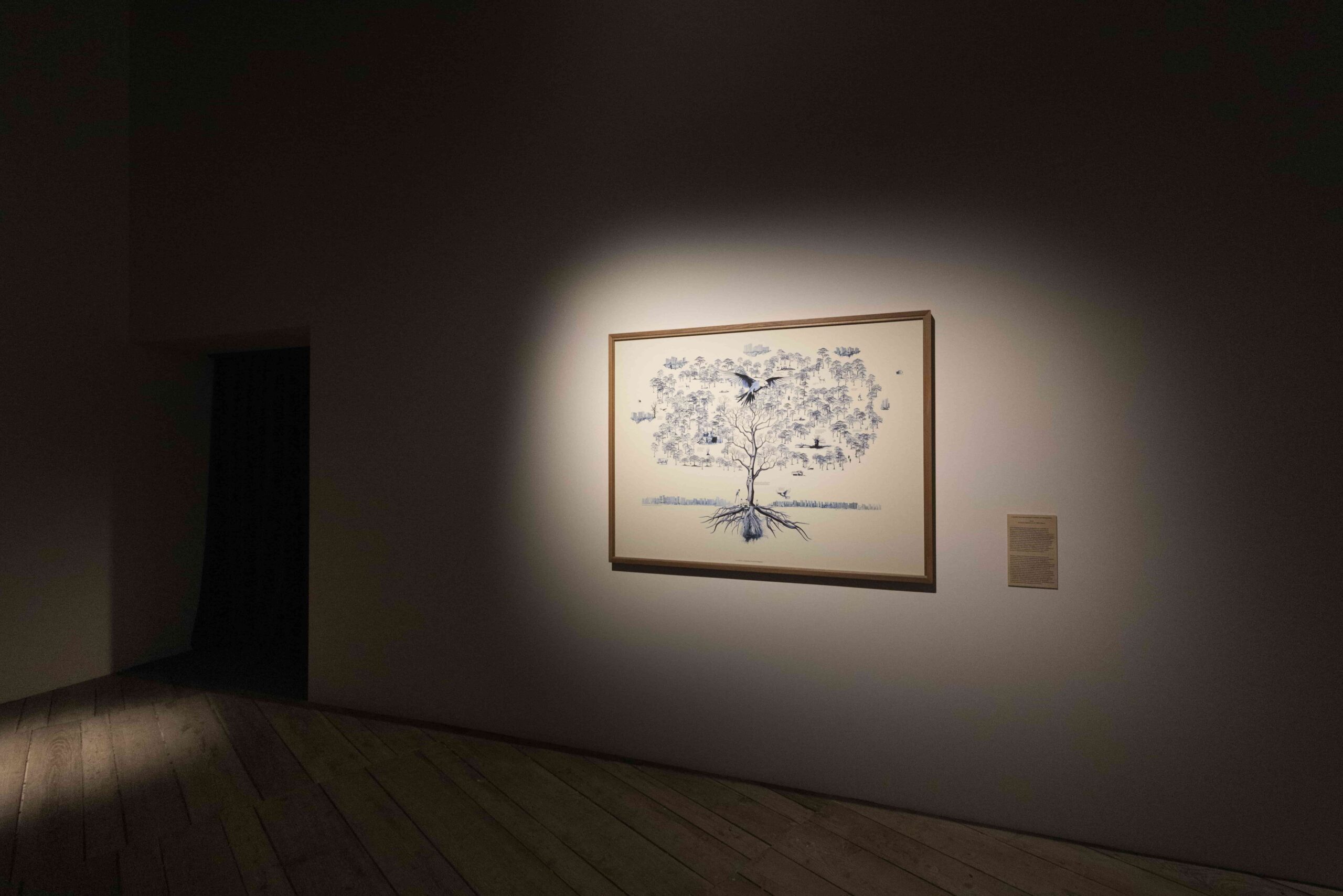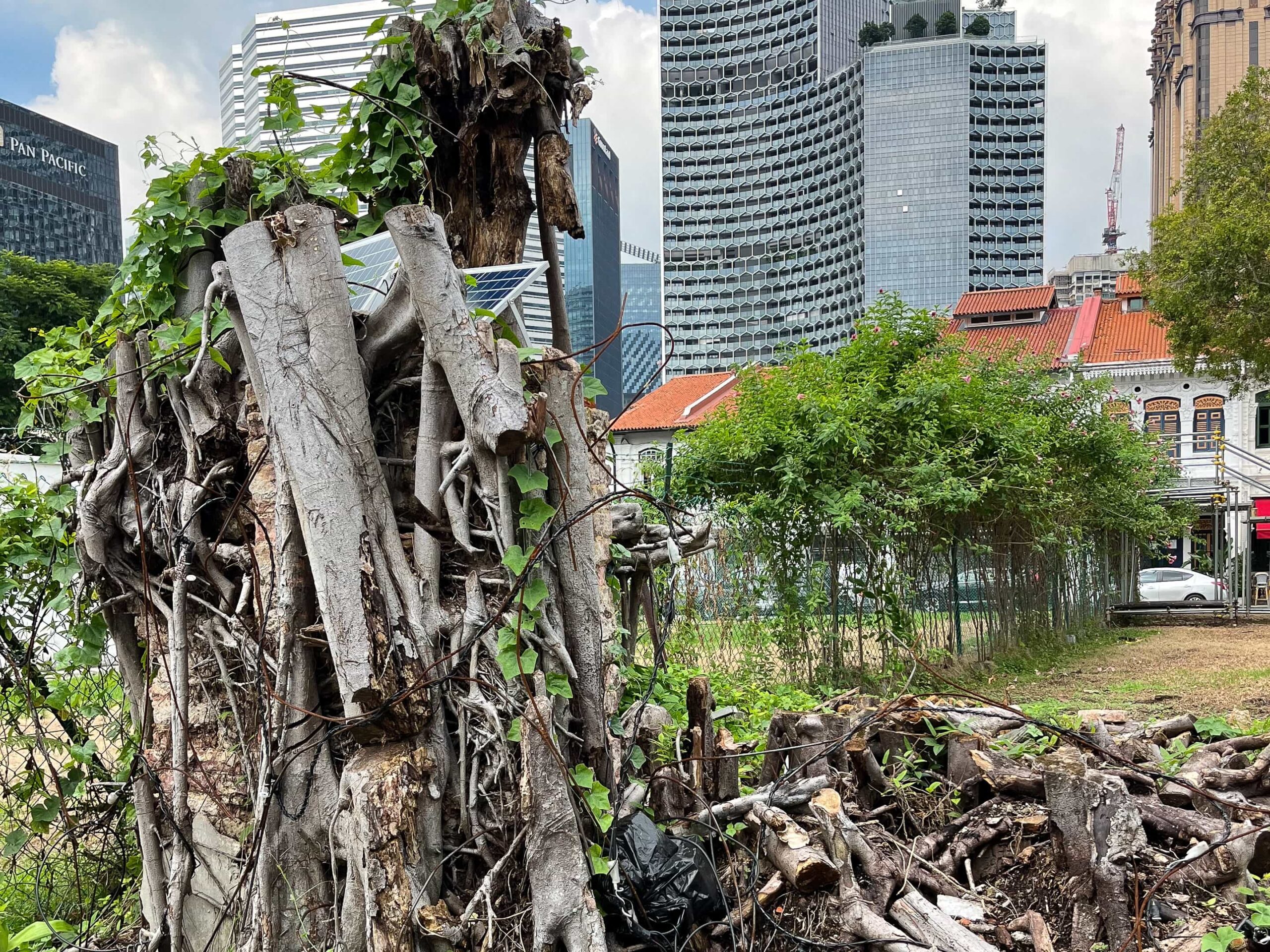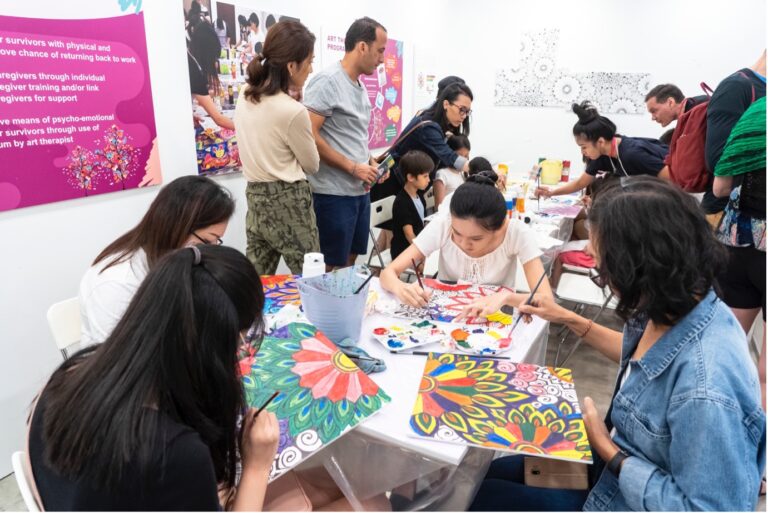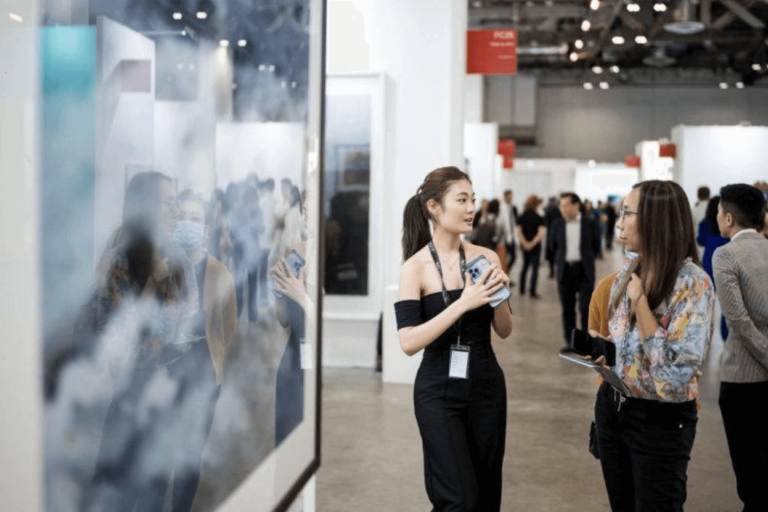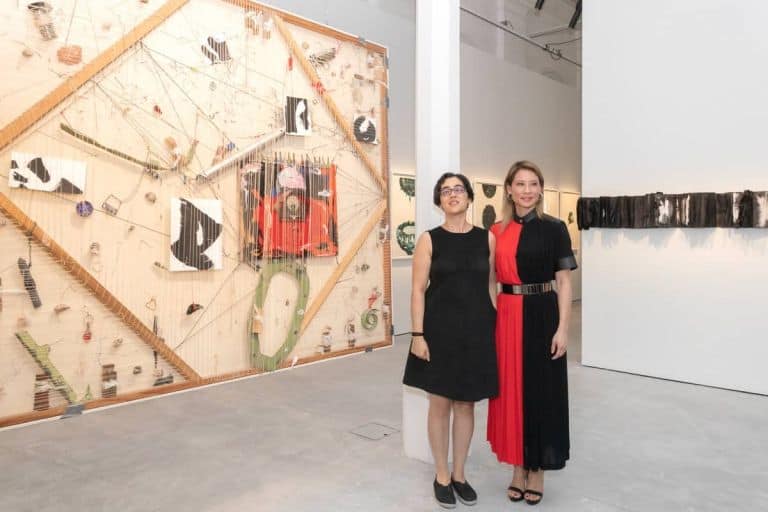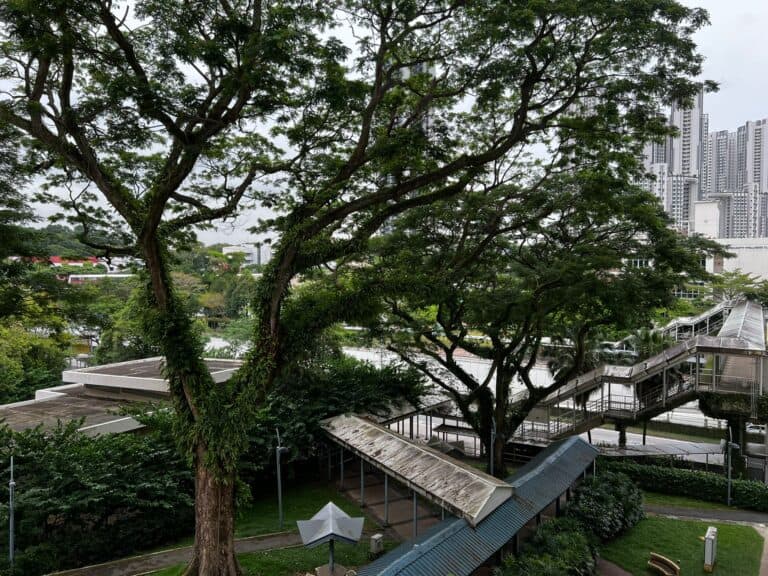If over fifty moving-image displays aren’t enough, there are fog machines, wayang kulit, and rooms lined with tatami mats. Ultraviolet light turns your skin a radioactive purple, and multi-channel sound booms through your bones. “Immersive” is a word that gets bandied about somewhat carelessly in art writing, but for once it feels like an appropriate descriptor. Now ongoing at the Singapore Art Museum (SAM), Ho Tzu Nyen’s mid-career retrospective Time & the Tiger is nothing short of spectacular.
Born in 1976, the visual artist, writer, theatre-maker, and filmmaker has made waves internationally. He’s been shown by major institutions like the Mori Art Museum and the Guggenheim, and at some of the biggest film festivals. Led by Eugene Tan, director of the National Gallery Singapore and SAM, the curatorial team has put together an ambitious production that showcases the thematic complexity of Ho’s oeuvre with sheer sensorial punch.
Multiverses and multiple histories
One of the first things that you’ll notice is Ho’s exuberant, eclectic visual style, which piles on image after image, channel-hopping between multiverses in a seemingly endless stream of juxtapositions—not unlike the Michelle Yeoh montages in Everything Everywhere All At Once (2023). But in Ho’s video installation The Nameless (2015), it’s Tony Leung Chiu-Wai who “stars” in a speculative narrative based on the life of Lai Teck, a triple-agent who worked for the French, British, and Japanese secret police in the 1930s–40s.
In The Nameless, Ho samples clips of Leung in his numerous acting roles and splices them together to a voiceover about Lai Teck. Anyone familiar with the legendary Hong Kong actor would recall the original films while watching Ho’s fan-edit—to vertiginous effect. Leung’s many acting personas are tangled with the life of Lai Teck, who went by over 30 aliases and remains shrouded in enigma.

If this sounds confusing, that is the point. Ho’s works chart a dense, dizzying network of literary, philosophical, cinematic, and historical references, cutting across genres, disciplines, and time. By borrowing existing imagery from visual art, cinema, and the Internet, the artist undercuts his own authority as the sole creator of a singular, easily digestible line of meaning.
Ho’s artistic strategies are decidedly Postmodern—in the sense that they suggest that knowledge is necessarily mired in uncertainty, and that there is no one truth, but, rather, many truths, depending on your point of view. “The single, authoritative, and often authoritarian narrative is the province of priests and judges, and the enemy of my work,” he tells Ocula magazine.
Aggregation
This resistance against grand narratives and neat historical timelines is, I think, aptly reflected in the way the show has been curated. While a more conventional retrospective might have attempted to link the artist’s works to his biography or to chart his major milestones, Time & the Tiger opts for a thematic approach. There aren’t any timelines or sections here; instead, the exhibition brochure includes a mindmap of sorts that the curators describe as an “aggregation of images.” Additionally, the wall texts defy convention—written from a first-person point of view, they make no claims to objectivity, instead revealing that curation is a subjective act of interpretation.
Aggregation, a word more often used in statistics and data collection, undergirds Ho’s practice. One of Ho’s starting points as an artist is collecting information, discourses, and images. “My processes of thinking often involve the creation of some kinds of maps to coordinate, and to complicate the relationships between these elements,” he tells the Japan Foundation Asia Center. Through non-hierarchical “collections” that can be rearranged, giving rise to multiple interpretative pathways, Ho rejects the idea that there can be simplistic, conclusive answers to any form of research.

Ho’s longest-running project, The Critical Dictionary of Southeast Asia (CDOSEA) (2012–ongoing), is an immense repository of video clips, sounds, and subtitles culled from the Internet. Organised by alphabetical keywords, CDOSEA poses the question: “What makes Southeast Asia a unified region when it has never been bound by a single religion, language or political system?”
By programming an algorithm to randomly select and sequence this massive database, Ho generates a potentially infinite number of films. CDOSEA proposes multiple inroads into understanding the region’s diffuse, uncertain identity, offering us an ever-changing, kaleidoscopic portrait of Southeast Asia.
I first encountered CDOSEA online, where I was invited to select a letter in the “dictionary” and to view the mini-film prompted by that letter. Much as I enjoyed viewing CDOSEA as a large-screen video installation at SAM, I wonder if something of the work’s original character has been lost in its new form.
In the online version, being able to skip between letters or revisit the same letter by clicking on it again really brought home the algorithm’s infinite changeability. As a virtual realm that has no solid geographical boundaries, the Internet also seems a better site for a project that is so deeply invested in concepts of deconstruction and decentralisation.
Time and time again
Moreover, CDOSEA occupies a crucial place in Ho’s oeuvre, serving as a jumping board for new works such as The Nameless, which emerged from the CDOSEA entry “L for Lai Teck.” Ho revisits his interest in aggregation and algorithmic selection—strategies used in CDOSEA—in T for Time (2023–ongoing), a new video installation co-comissioned by SAM and several other art institutions. Billed as a “collection of Tzu’s notes and speculations on time,” the work superimposes animated motifs over photographic images.


“Time is the chief protagonist in my works,” says the artist. The many layers of imagery that co-exist in Ho’s works speak to his understanding of temporal simultaneity. That is, the sense that history isn’t simply experienced as one big story, but as many, many little stories; that time is felt and lived differently by different people even within the same historical moment.
This temporal simultaneity is expertly reflected in the exhibition’s spatial design. While The Nameless focuses on the triple-agent Lai Teck, The Name (2015) centres on another mysterious character in the history of modern Southeast Asia: Gene Z. Hanrahan, the purported author and editor of books including The Communist Struggle in Malaya, and a suspected cover for the CIA. The Name and The Nameless, which were clearly intended as companion pieces, are displayed in “rooms” separated by translucent mesh screens. While watching Tony Leung puff on cigarettes in The Nameless, I could also see the dim, ghostly silhouettes of other visitors milling around in the gallery where The Name was being shown. It felt, for a moment, as if time was forking into parallel universes, as in Jorge Luis Borges’ story The Garden of Forking Paths (Ho has previously cited the Argentine writer as one of his influences).

Sensory immersion…or too much all at once?
Despite its conceptual significance, the multi-channel sound occasionally detracts from the work’s immersiveness, as in Hotel Aporia (2019). First shown at the Aichi Triennale 2019, the multi-narrative film was designed as a site-specific installation for Kiraku-Tei, a popular Japanese-style traditional inn where a group of kamikaze pilots had their final dinner during WW2.
The six video projections in the work consist of re-worked snippets from films by the auteur Yasujirō Ozu and the animator Ryuichi Yokoyama. By manually altering each frame, Ho obscures the faces of the characters. Meanwhile, the soundtrack narrates letters and emails exchanged between Ho and the Japanese curators, translators, and collaborators who helped him with his research.

By imagining this diverse cast of characters in dialogue, Ho delves into the ideological discourses that circulated during WW2. An “aporia” is a contradiction that can’t be resolved—in this case, between Japan’s utopian vision of a pan-Asian union against Western imperialism, and the aggressive, cruel war it waged across Asia. It’s a complex work that delves into Zen Buddhist philosophies about nothingness and the role of filmmaking in wartime propaganda, all while grappling with the ghosts of Japan’s imperialist past.
To parse all of this is, of course, not an easy feat. Listening to the 24-channel sound track all at once, with the doors to each room left open (presumably to reflect Ho’s interest in multiplicity) was frankly quite overwhelming. I found myself wishing for pockets of silence where I could process the sheer volume of new information. A friend of mine who visited Time & the Tiger remarked that he would’ve preferred to read Ho’s research in a book. While I disagree, I think he raises a good point: with so much audiovisual information hurled at us, and with the persistent, sometimes disruptive sound bleed throughout the exhibition, it can be hard to focus on the nuances in Ho’s work.
The advantages of seeing many of Ho’s works at once are clear: we get a good sense of the breadth and depth of his practice, and of his sustained inquiry into Southeast Asia. But given that each of his works is at once a dense theoretical exposition and an all-consuming sensory experience, I wonder if the format of a retrospective is really appropriate to the kind of intense engagement that these time-based video works demand.
In any case, there’s much to be gained from fully engaging in the singular aesthetic experience that each work aims to create.
Inspired by the clouds in Chinese landscape painting and philosophical ideas about emptiness, The Cloud of Unknowing is a medley of surreal slice-of-life vignettes focusing on the residents of a HDB block. With an immersive 13-channel soundtrack, the large-screen video installation plunges the viewer into an all-consuming sensory experience somewhere between a dream and a symphonic performance.

In one scene, an albino man wearing a diaper bathes in a vaguely baptismal pool, as the dye leaches out of his white hair. In another, a man with burns on the skin of his back resides in a cluttered room reminiscent of photographer Jeff Wall’s After “Invisible Man” by Ralph Ellison, the Prologue (1999–2000). I wonder why Ho chose to cite, by proxy, Ralph Ellison’s novel about a young African-American who was made “invisible” in a racist society that refused to “see” him as an equal. Might The Cloud of Unknowing be read as a challenge to the viewer to acknowledge those living on the margins of social visibility, hidden in clouds of unknowing?

Art about history: for what, and for whom?
In an article on the proliferation of research-based practices in contemporary art, art historian Claire Bishop argues that the “richest possibilities … emerge when preexisting information is not simply cut and pasted, aggregated, and dropped in a vitrine but metabolised by an idiosyncratic thinker who feels their way through the world.”
Bishop suggests that the collection of data becomes an interesting and meaningful practice when artists lay out the stakes of their research, articulating why and for whom they conduct their intellectual labour. Likewise, I find Ho’s work the strongest where it suggests why audiences should care about his collection of multiple histories.

One Or Several Tigers (2017), the final work in the exhibition, drives home why time and tigers matter. The video installation references a 19th-century wood engraving by Heinrich Leutemann, which depicts a tiger interrupting a group of road surveyors. Strangely, the tiger leaps for the theodolite (a surveying instrument), leaving the crew unscathed—almost as if the sole purpose of its attack was to disrupt the colonial enterprise of mapping, which allowed the British to govern and extract resources from their colonies.

Rather than focusing on Coleman, who laid the first blueprint for modern Singapore, Ho zooms in on his assistants: Indian convicts who were recruited as labourers. Through an operatic two-channel video, we learn that they were subject to harsh living conditions, encouraged to snitch on one another in a system of self-surveillance, and eventually forced to build the structure that would become their own prison.
The video then cuts to a group of Indian men dressed in contemporary clothing— flannel and polo shirts, blue jeans, simple backpacks—looking at the framed wood engraving in a space resembling an art gallery. The implications are clear: time loops backwards and history repeats itself, as the exploitation that colonial Singapore was built on continues today.
As Ho tells The Straits Times, “In some sense, I believe this is the genealogy of our reliance on foreign labour.” One Or Several Tigers suggests that addressing the historical past might open up avenues for understanding and dismantling the oppressive systems that persist in the present.
Time & the Tiger is an exhibition well-worth seeing—perhaps in segments, and more than once—simply because it takes time to wrestle with the histories, myths, legends, and characters that Ho conjures through his time-based art.
In a world oversaturated with media imagery and plagued by increasingly polarised politics, Ho’s practice offers insight into the value of reckoning with multiple histories and holding space for divergent points of view. Though the retrospective might feel like a speed run through a movie-slash-lecture marathon, viewers who persist through the dense material and learn to sit with the discomfort of not knowing will find themselves richly rewarded—with an immensely stimulating vision of what it means to live with the untameable beasts of history and time.
_______________________________
Ho Tzu Nyen: Time & the Tiger runs at the Singapore Art Museum until 3 March 2024.
Header image: Ho Tzu Nyen, T for Time: Timepieces (2023-ongoing), video, app, and flatscreens. Image courtesy of Singapore Art Museum. Images by the author unless stated otherwise.
